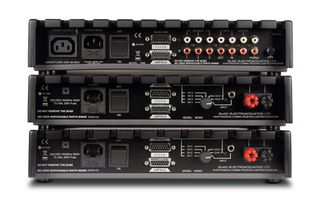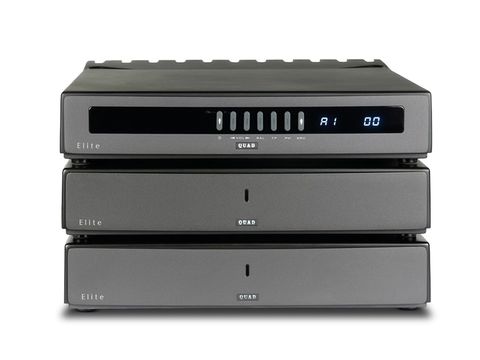TechRadar Verdict
Pros
- +
Clear and well focused bass which never becomes excessive
Cons
- -
Slight sibilance which may bother some listeners
Why you can trust TechRadar
With its track record in audio now exceeding three-score years and ten, Quad remains true to its original aims in offering unique audio products that are immediately recognisable.
The Elite range, which over the last year or so has replaced the respected 99 Series, aims to incorporate audiophile design in small, smart and easily connected matching units, with source and amplification components sharing a basic case design.
They can all be connected with the usual phono sockets, but Quad's default hookup is the 'Ampbus', a 15-way D socket on the back of each unit which is connected to the next unit in the chain with a supplied ribbon connector, carrying balanced audio (and control) signals.
There is a stereo power amp in the range, but for this test we chose a pair of mono amps, each rated at 150 watts output. There are few things simpler than a mono power amp, but these have one unusual feature in the rear-mounted switch which selects their channel from the six potentially available on Ampbus – you need to set one to '1' and one to '2' for stereo or you'll get mono sound. (Or use the phono input.)
The preamp features three phono socket line inputs, as well as Ampbus, plus an RIAA phono input. Internally it's very well filled with high performance op-amps and electronic switching and attenuating components, the complexity partly due to the inclusion of tone controls (defeatable, of course) as well as the comprehensive in and out options.
Both pre and power amps are neatly built with entirely through-hole components of good quality.
Sound quality

This is another amplifying ensemble where subjective performance seems to be dominated by perceived minor irregularities in the treble.
In unusually analytical vein, one listener suggested that there is, paradoxically, less edge and bite to the sound, but slightly more sibilance. Impossible? Perhaps not, if one accepts that the treble is actually quite a broad band and 'edge' and 'sibilance' belong to different parts of it.
Our experience is that sibilance is a function of the octave below the very top one, while the highest octave of hearing can often manifest as subjective 'edge' – and also, on some occasions, very much further down the spectrum, having a knock-on effect on bass.
If there is any effect on the bass here, then it's clearly very minor. There's an unfussy approach to bass that works well. When we made a point of listening for low-frequency sounds, we found they were invariably strong, clearly focused and well-pitched, too when appropriate, but they never leap out.
Midrange is also very well balanced, while imaging is wide, deep and well defined. And then there's the question of dynamics, which is complicated by the treble character noted above. Longer-term dynamics work very well and low percussion fares best in this regard, but sudden loud sounds from bright melodic instruments do seem a little polite by comparison with more overtly dynamic amps.
The sound has good detail, though and overall this is a pleasing and rewarding combination for long-term listening.
Follow TechRadar Reviews on Twitter: http://twitter.com/techradarreview

